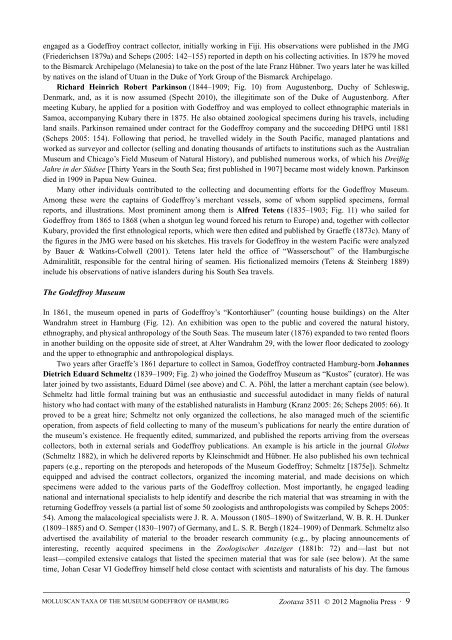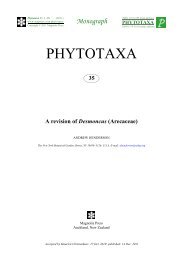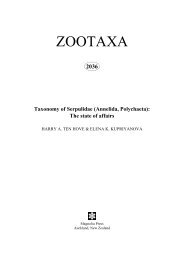Create successful ePaper yourself
Turn your PDF publications into a flip-book with our unique Google optimized e-Paper software.
engaged as a Godeffroy contract collector, initially working in Fiji. His observations were published in the JMG<br />
(Friederichsen 1879a) and Scheps (2005: 142–155) reported in depth on his collecting activities. In 1879 he moved<br />
to the Bismarck Archipelago (Melanesia) to take on the post of the late Franz Hübner. Two years later he was killed<br />
by natives on the island of Utuan in the Duke of York Group of the Bismarck Archipelago.<br />
Richard Heinrich Robert Parkinson (1844–1909; Fig. 10) from Augustenborg, Duchy of Schleswig,<br />
Denmark, and, as it is now assumed (Specht 2010), the illegitimate son of the Duke of Augustenborg. After<br />
meeting Kubary, he applied for a position with Godeffroy and was employed to collect ethnographic materials in<br />
Samoa, accompanying Kubary there in 1875. He also obtained zoological specimens during his travels, including<br />
land snails. Parkinson remained under contract for the Godeffroy company and the succeeding DHPG until 1881<br />
(Scheps 2005: 154). Following that period, he travelled widely in the South Pacific, managed plantations and<br />
worked as surveyor and collector (selling and donating thousands of artifacts to institutions such as the Australian<br />
Museum and Chicago’s Field Museum of Natural History), and published numerous works, of which his Dreißig<br />
Jahre in der Südsee [Thirty Years in the South Sea; first published in 1907] became most widely known. Parkinson<br />
died in 1909 in Papua New Guinea.<br />
Many other individuals contributed to the collecting and documenting efforts for the Godeffroy Museum.<br />
Among these were the captains of Godeffroy’s merchant vessels, some of whom supplied specimens, formal<br />
reports, and illustrations. Most prominent among them is Alfred Tetens (1835–1903; Fig. 11) who sailed for<br />
Godeffroy from 1865 to 1868 (when a shotgun leg wound forced his return to Europe) and, together with collector<br />
Kubary, provided the first ethnological reports, which were then edited and published by Graeffe (1873c). Many of<br />
the figures in the JMG were based on his sketches. His travels for Godeffroy in the western Pacific were analyzed<br />
by Bauer & Watkins-Colwell (2001). Tetens later held the office of “Wasserschout” of the Hamburgische<br />
Admiralität, responsible for the central hiring of seamen. His fictionalized memoirs (Tetens & Steinberg 1889)<br />
include his observations of native islanders during his South Sea travels.<br />
The Godeffroy Museum<br />
In 1861, the museum opened in parts of Godeffroy’s “Kontorhäuser” (counting house buildings) on the Alter<br />
Wandrahm street in Hamburg (Fig. 12). An exhibition was open to the public and covered the natural history,<br />
ethnography, and physical anthropology of the South Seas. The museum later (1876) expanded to two rented floors<br />
in another building on the opposite side of street, at Alter Wandrahm 29, with the lower floor dedicated to zoology<br />
and the upper to ethnographic and anthropological displays.<br />
Two years after Graeffe’s 1861 departure to collect in Samoa, Godeffroy contracted Hamburg-born Johannes<br />
Dietrich Eduard Schmeltz (1839–1909; Fig. 2) who joined the Godeffroy Museum as “Kustos” (curator). He was<br />
later joined by two assistants, Eduard Dämel (see above) and C. A. Pöhl, the latter a merchant captain (see below).<br />
Schmeltz had little formal training but was an enthusiastic and successful autodidact in many fields of natural<br />
history who had contact with many of the established naturalists in Hamburg (Kranz 2005: 26; Scheps 2005: 66). It<br />
proved to be a great hire; Schmeltz not only organized the collections, he also managed much of the scientific<br />
operation, from aspects of field collecting to many of the museum’s publications for nearly the entire duration of<br />
the museum’s existence. He frequently edited, summarized, and published the reports arriving from the overseas<br />
collectors, both in external serials and Godeffroy publications. An example is his <strong>article</strong> in the journal Globus<br />
(Schmeltz 1882), in which he delivered reports by Kleinschmidt and Hübner. He also published his own technical<br />
papers (e.g., reporting on the pteropods and heteropods of the Museum Godeffroy; Schmeltz [1875e]). Schmeltz<br />
equipped and advised the contract collectors, organized the incoming material, and made decisions on which<br />
specimens were added to the various parts of the Godeffroy collection. Most importantly, he engaged leading<br />
national and international specialists to help identify and describe the rich material that was streaming in with the<br />
returning Godeffroy vessels (a partial list of some 50 zoologists and anthropologists was compiled by Scheps 2005:<br />
54). Among the malacological specialists were J. R. A. Mousson (1805–1890) of Switzerland, W. B. R. H. Dunker<br />
(1809–1885) and O. Semper (1830–1907) of Germany, and L. S. R. Bergh (1824–1909) of Denmark. Schmeltz also<br />
advertised the availability of material to the broader research community (e.g., by placing announcements of<br />
interesting, recently acquired specimens in the Zoologischer Anzeiger (1881b: 72) and—last but not<br />
least—compiled extensive catalogs that listed the specimen material that was for sale (see below). At the same<br />
time, Johan Cesar VI Godeffroy himself held close contact with scientists and naturalists of his day. The famous<br />
MOLLUSCAN TAXA OF THE MUSEUM GODEFFROY OF HAMBURG<br />
Zootaxa 3511 © 2012 <strong>Magnolia</strong> <strong>Press</strong> · 9
















